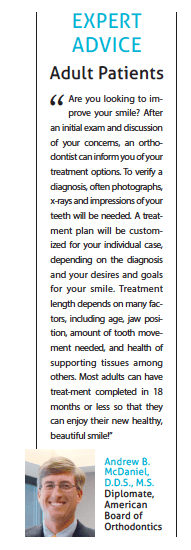It’s not just about having a pretty smile. Orthodontic treatment sets you up for a healthier mouth in the long run.

 It Starts With Your Bite In an ideal bite (or “occlusion”), the lips close comfortably around well-aligned teeth and the upper teeth are slightly ahead of and overlapping the lower teeth. Unfortunately, many of us have crooked or spaced teeth combined with a less-than-ideal bite – a condition known as “malocclusion.”
It Starts With Your Bite In an ideal bite (or “occlusion”), the lips close comfortably around well-aligned teeth and the upper teeth are slightly ahead of and overlapping the lower teeth. Unfortunately, many of us have crooked or spaced teeth combined with a less-than-ideal bite – a condition known as “malocclusion.”
The Problem With Malocclusion For one, you may not like the way your teeth look or the way your bite impacts the shape of your face. But beyond that, crooked teeth are prone to excessive wear and are difficult to clean, which can lead to tooth decay and even tooth loss. If jaw issues are severe enough, they can also cause pain and problems with eating, breathing, or speaking. Unfortunately, these problems typically only get worse as time goes on.
What Orthodontic Treatment Does Orthodontists are dentists with specialized training who use braces (fixed appliances) or removable appliances to improve tooth alignment and jaw position. Your orthodontist can determine which orthodontic treatments are best for you after an initial consultation and thorough examination of your needs. Receiving a proper diagnosis is critical to the success of orthodontic treatment. Often, an orthodontist will need to coordinate with your general dentist or other specialists for best results.
Starting Treating Some conditions benefit from orthodontic treatment during the primary (or baby) tooth stage. However, most patients begin orthodontic treatment after all of the permanent teeth have erupted (around 10 to 14 years of age). Of course, it’s never too late to start treatment! Adult orthodontic treatment is very popular today, and there are many clear or nearly invisible options available.
Understanding Rabies
How to Protect Yourself and Your Pets An animal bite can be worrisome, especially if it’s not just a nip from …

